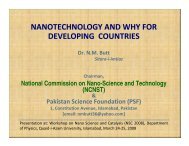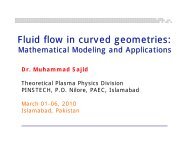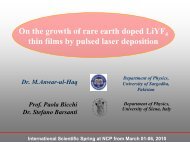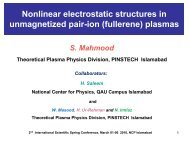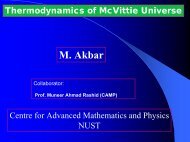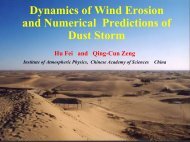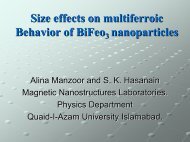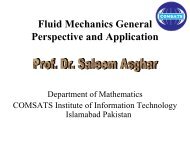The origin of exchange Bias
The origin of exchange Bias
The origin of exchange Bias
You also want an ePaper? Increase the reach of your titles
YUMPU automatically turns print PDFs into web optimized ePapers that Google loves.
<strong>The</strong> Origins <strong>of</strong> Exchange<strong>Bias</strong>Sadia ManzoorDepartment <strong>of</strong> PhysicsCOMSATS Institute <strong>of</strong> Information Technology, IslamabadCo-workers:K. O’Grady, L. E. Fernández-Outón and G.Vallejo-Fernández, Department <strong>of</strong>Physics, University <strong>of</strong> York, U.K.M. Farooq Nasir, Department <strong>of</strong> Physics, COMSATS IIT, Islamabad
Overview• Exchange bias … what is it?• No single theory … why??• Issues still open• Time dependence in AFMs• Measuring <strong>exchange</strong> bias» thermal activation effects• Modeling <strong>exchange</strong> bias• Conclusions» the independent AFM grain model2
Order in magnetic systemsferromagnetT > T CT < T CantiferromagnetT > T NT < T N3
Exchange bias• s<strong>of</strong>t ferromagnetM• pinned ferromagnetInterfacial <strong>exchange</strong> anisotropyCoercivity H CHMHH cHferromagnet antiferromagnetT < T CT < T NH EX4
<strong>The</strong> ‘rigid’ AFM picture5
Issues still open• H ex obtained from the ‘rigid’ AFM model >> H exobtained experimentally• at least 5 different theories have been proposed• still no single working theory (i.e. one that can takeaccount <strong>of</strong> interfacial as well as bulk effects)• new phenomena and effects are still being found• despite this we all use <strong>exchange</strong> bias every day (!)Why is this so?6
Time Dependence inAntiferromagnetseasy axisαMEAFM grainΔ EManisotropy energy <strong>of</strong> the AFM: E = K V sin 2 α0 π/2 παAnisotropy energy barrier: Δ E = K Vfrequency <strong>of</strong> reversal: f = f o exp ( - ΔE / k B T)relaxation time: τ = τ o exp ( ΔE / k BT)small particles become thermally unstable at hightemperatures7
all polycrystalline samples have distribution <strong>of</strong> grain volumes …f(V)Δ E = KVdistribution <strong>of</strong> grain volume dependent energy barriers toreversal <strong>of</strong> the AFMFor a given (H, T), there exists a critical value <strong>of</strong> theanisotropy energy barrier ΔE C(or critical grain volume V C)such that all grains withΔE > ΔE Care thermally stable (blocked)(V > V C)and all those withΔE < ΔE Care thermally unstable (unblocked)(V < V C)unblockedblocked8
ΔE C= KV C= k BThigh temperatures cause parts <strong>of</strong> the AFto disorderunblockedblockedonly the blocked grains cause<strong>exchange</strong> biasHblocked AFM grainsUnblocked AFM grainsH ex should depend upon the degree <strong>of</strong> order in the AFM!9
<strong>The</strong>rmal activation measurementssetting the AFMΔE C= KV SET= k BT SETactivating the AFMsetΔE C= KV C= k BT ACTnot setV SET Vsetnot setHEX(H,T)=C*(H,T)HiEXVSET∫VCf(V)dVV Cset in oppositesenseV SET VHCiEX*::intrinsic <strong>exchange</strong> biasinterfacial coupling constant
Reversal in IrMn(5nm)/CoFe(10nm)H EX (Oe)3002001000-100-200-300100 150 200 250 300 350 400Tact (K)T B11
Si/FeMn(10 nm)/NiFe(10 nm)/ Ta(15 nm)Sample ASample Bfrequency (%)15105D m= 3.6 nm00 2 4 6 8 10 12 14grain diameter (nm)1000 10 20 30 40 50 60frequency (%)20D m= 16.8 nmgrain diameter (nm)12
Grain size distribution for sample SBSi/FeMn(10 nm)/NiFe(10 nm)/ Ta(15 nm)fVσm1 ⎡ {ln ( V VV ) = exp ⎢ −2πσV⎣ 2σ: median grain volumem(2: s tan darddeviation)}2⎤⎥⎦13
*iH ( H,T)= C ( H,T)H f ( V)EXEXVSET∫VCdVfVσm1 ⎡ {ln ( V VV ) = exp ⎢ −2πσV⎣ 2σ: median grain volumem(2: s tan darddeviation)}2⎤⎥⎦relaxation time: τ = τ o exp ( K V / k B T)using t SET = 5400 s and t ACT = 1800 sln (tf) kSET o B SETVSET= andKAFMTV =Cln (tACTfKo) kAFMBTACTwhere f o = 10 9 s -114
T B = 165 KHEX*i(H,T) = C (H,T) HEX∫VSETVC2π σ1( V/ VM⎛ −exp)⎜⎝[ ln (V/ V22σM) ]2⎞⎟ dV⎠VM:mediangrainvolumeσ:standarddeviation15
!NOTE: at T = T B , H EX = 0Exact halves <strong>of</strong> the AFM particle volumedistributions are ordered in opposite sensesV =Mln (tfKACToAFM) kBTBV MVK AFM (165 K) = 2.96 × 10 5 erg/cm 3K AFM (293 K) = 1.85 × 10 5 erg/cm 3(K AFM (293 K) = 1.35 × 10 5 erg/cm 3 reported by Mauri et al.)D. Mauri, E. Kay, D. Scholl, and J. Kent Howard, J. Appl. Phys. 62, 292 (1987)16
Exchange biased nanocomposites• core-shell nanoparticles• FM nanoparticles embedded in an AFM matrix“Beating the superparamagnetic limit with<strong>exchange</strong> bias”Vassil Skumryev, Stoyan Stoyanov, YongZhang, George Hadjipanayis, DominiqueGivord and Josep NoguésNATURE, Vol. 423, p. 850 (2003)17
Understanding these systems is much more complex than FM/AFM bilayers in whichH ex∝ 1/t FMand H ex∝ t AFMIn nanocomposite systems….definition <strong>of</strong> ‘thickness’ is an issuefor FM …. particle diameter ~ FM thickness (but percolation effects)for AFM…. distance between FM particles ~ AFM thicknessPROBLEM: these cannot be controlled independently <strong>of</strong> one another as in thin films18
Co-Cr 2O 3nanocomposites prepared by sol gel:sample wt. % CoA 30B 40C 50D 60E 80fcc Co nanoparticles embedded in Cr 2O 3matrixIncreasing Co concentrationincreasing FM / AFM interface densityeffect on <strong>exchange</strong> bias??? ≈ 3 – 4 nm, ≈ 24 nmvalidity <strong>of</strong> the independent AFM grain modelfor super <strong>exchange</strong> coupled AFM’s??19
H ex (Oe)200150100500-50-100-150-200A0 50 100 150 200 250 300T ACT (K)H ex (Oe)T B= 148 KV SET∫V Cf ( V ) dVV SET∫V C10-1f ( V ) dVH ex (Oe)3002001000-100-200BH ex (Oe)T B= 148 K0 50 100 150 200 250 300T ACT(K)V SET∫V CV SET∫V Cf ( V ) dV10-1f ( V ) dV150100C1150100C1150500-50-100-150T B= 148 K-2000 50 100 150 200 250 300T ACT(K)0-10-50-100-150T B= 165 K0 50 100 150 200 250 300T ACT(K)0-1•T Bdepends only upon the median AFM particle volume V m.• data can be described by the independent AFM particle model, i.e.VSET*i 1 ⎛ − [ ln (V/ VHEX(H,T)= C (H,T) HEX∫exp22 ( V/ V )⎜2V π σM ⎝ σCM) ]2⎞⎟ dV⎠usingV =Mln (tfKACToAFM) kBTB20
For Cr 2O 3…T N= 310 K ⇒ T SET> T Nis possible! ⇒ entire f (V) can be setHEX*i(H,T) = C (H,T)H f (V) dV= 1Separation <strong>of</strong> bulk and interfacial effects !!!EX∫C * H EXidepends non-monotonically uponFM/AFM interface densityH exitself is governed by both bulk andinterfacial effectsC * Hex i (Oe)20015010030 40 50 60 70 80Co Concentration (wt. %)21
Conclusions• H exis controlled not only by the degree <strong>of</strong> order in the bulk antiferromagnetbut also by interfacial effects.• <strong>The</strong>se effects relate to the stiffness <strong>of</strong> the <strong>exchange</strong> coupling acrossthe interface between the ferromagnetic layer and the antiferromagnet.• <strong>The</strong>oretical models such as the rigid AF model oversimplify the role <strong>of</strong>the AF by merely taking into account an anisotropy and <strong>exchange</strong>stiffness constant. <strong>The</strong>y are only valid as first order approximations.Others like the domain state model overcomplicate the picture.• <strong>The</strong> results presented provide evidence <strong>of</strong> the need to introduce thermalactivation and AF order related parameters in the Hamiltonian <strong>of</strong> themodels proposed to explain <strong>exchange</strong> bias.22
References• Interfacial Spin Order in Exchange <strong>Bias</strong>ed SystemsL. E. Fernández-Outón, G. Vallejo-Fernández, Sadia Manzoor, B.Hillebrands and K. O’GradyJournal <strong>of</strong> Applied Physics 104, 093907 (2008)• Bulk and Interfacial Effects in Co – Cr 2O 3NanocompositesM. Farooq Nasir, H. Hoon, K. O’Grady and Sadia ManzoorInternational Journal <strong>of</strong> Nanoscience and Nanotechnology (2010)(in press)Acknowledgements• Dr. Umair Manzoor for TEM images• Higher Education Commission, GoP• Commonwealth Foundation, U.K.• Hitachi Global Storage Technologies (HGST), San José, California• Seagate Technology, N. Ireland23
Acknowledgements• Dr. Umair Manzoor for TEM images• Higher Education Commission, GoP• Commonwealth Foundation, U.K.• Hitachi Global Storage Technologies (HGST), San José, California• Seagate Technology, N. Ireland24
Energy per unit area <strong>of</strong> FM/AFM bilayerE = - H M FM t FM cos (θ - β) + K AFM t AFM sin 2 (α) -J INT cos (β - α)M AFMK AFM• K AFM t AFM < J INT⇒ AFM spins rotate with θ the FM spinsM FMHβθαno loop shift• K AFM t AFM > J INT⇒ pinning <strong>of</strong> FM spins by the AFM loop shiftMinimizing energy with respect to β keeping α small (≅ const.)Hex=JMFMINTtFM25
High Target Utilization Sputtering(HiTUS)SIDE ARMPLASMA SOURCERFpowerunitRotating substrate tableLaunchelectromagnetReactivegas feedAr gasfeedTargetsHighly ionized plasma‘beam’ generated in sidearm and directed to targetby electromagnetsPumpsystemsDC/RF 0-1000Vtarget bias27
AFM pinning layer e.g. IrMn, FeMnFM (pinned) layer e.g. CoFe, NiFeNon-magnetic spacer layer e.g. CuFM (free) layer e.g. CoFe, NiFe} EXCHANGE BIASED BILAYERI inI outSV sensorRecordingmedium29
In order to obtain the intrinsicbehaviour <strong>of</strong> <strong>exchange</strong> biasedmaterials, it is essential to measurein thermal activation free conditionsDetermination <strong>of</strong> thermal activationfree temperatureRecoil loops for a IrMn(5nm)/CoFe(10nm)<strong>exchange</strong> couple⇒ T NA= 100 K30
Grain size control through control <strong>of</strong> V bias<strong>of</strong> the FM and AFM layersSample Layer composition V bias (V)ANiFe (10 nm) 200FeMn (10 nm) 600BNiFe (10 nm) 1000FeMn (10 nm) 1000SG1CoFe (3 nm)IrMn (10 nm)--31



